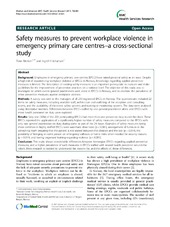| dc.contributor.author | Morken, Tone | en_US |
| dc.contributor.author | Johansen, Ingrid Hjulstad | en_US |
| dc.date.accessioned | 2014-02-26T07:59:05Z | |
| dc.date.available | 2014-02-26T07:59:05Z | |
| dc.date.issued | 2013-10-03 | eng |
| dc.Published | BMC Health Services Research 13:384 | eng |
| dc.identifier.issn | 1472-6963 | |
| dc.identifier.uri | https://hdl.handle.net/1956/7821 | |
| dc.description.abstract | Background: Employees in emergency primary care centres (EPCC) have raised personal safety as an issue. Despite a high risk of experiencing workplace violence at EPCCs in Norway, knowledge regarding applied preventive measures is limited. The description of existing safety measures is an important prerequisite to evaluate and make guidelines for the improvement of preventive practices on a national level. The objective of this study was to investigate to which extent general practitioners work alone in EPCCs in Norway, and to estimate the prevalence of other preventive measures against workplace violence. Methods: A survey was sent to the managers of all 210 registered EPCCs in Norway. The questionnaire included 22 items on safety measures, including available staff, architecture and outfitting of the reception and consulting rooms, and the availability of electronic safety systems and training or monitoring systems. The data were analysed using descriptive statistics. Differences between EPCCs staffed by one general practitioner alone and EPCCs with more health personnel on duty were explored. Results: Sixty-one (30%) of the 203 participating EPCCs had more than one person on duty round-the-clock. These EPCCs reported the application of a significantly higher number of safety measures compared to the EPCCs with only one general practitioner on duty during some or part of the 24 hours. Examples of safety measures being more common in highly staffed EPCCs were automatic door locks (p < 0.001), arrangement of furniture in the consulting room ensuring that the patient is not seated between the clinician and the exit (p = 0.014), the possibility of bringing an extra person on emergency call-outs or home visits when needed for security reasons (p = 0.014), and having organised training regarding violence (p < 0.001). Conclusion: This study shows considerable differences between Norwegian EPCCs regarding applied preventive measures, and a higher prevalence of such measures in EPCCs staffed with several health personnel around-the -clock. More research is needed to understand the reasons for, and the effects of, these differences. | en_US |
| dc.language.iso | eng | eng |
| dc.publisher | BioMed Central | eng |
| dc.rights | Attribution CC BY | eng |
| dc.rights.uri | http://creativecommons.org/licenses/by/2.0/ | eng |
| dc.title | Safety measures to prevent workplace violence in emergency primary care centres - a cross-sectional study | en_US |
| dc.type | Peer reviewed | |
| dc.type | Journal article | |
| dc.date.updated | 2013-10-16T15:08:24Z | |
| dc.description.version | publishedVersion | en_US |
| dc.rights.holder | Copyright 2013 Morken and Johansen; licensee BioMed Central Ltd. | |
| dc.rights.holder | Tone Morken et al.; licensee BioMed Central Ltd. | |
| dc.source.articlenumber | 384 | |
| dc.identifier.doi | https://doi.org/10.1186/1472-6963-13-384 | |
| dc.identifier.cristin | 1084373 | |
| dc.source.journal | BMC Health Services Research | |
| dc.source.40 | 13 | |

